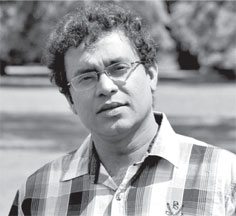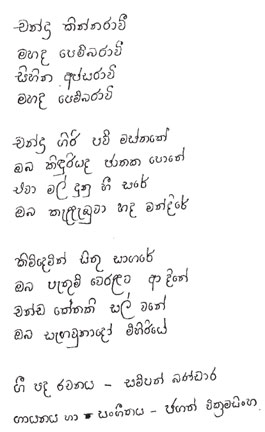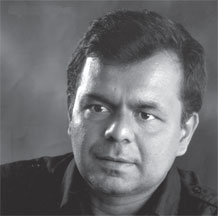|
Chandrakinnarawee mahada apsarawee:
Interplay of classical music and literature
By Ranga CHANDRARATHNE
The song Chandrakinnarawee mahada apsarawee,a lyric written by
Sampath Bandara and music composed and sung by Jagath Wickramasinghe is
one of the enthralling contemporary Sinhala songs.
 |
|
Jagath Wickramasinghe |
A significant factor which distinguishes Chandrakinnarawee from
scores of other songs is that lyricist has amply demonstrated that he is
not only well-versed in the craft of lyric writing but also
knowledgeable to apply classical Sinhala literature in the contemporary
context.
At the commencement of the song, Sampath Bandara has exploited the
poetic properties in Sinhala language such as the use of rhyming
syllables. However, in the second stanza, he skilfully shifts on to
contemporary form of Sinhala song.
As the song is a passionate separation from a lover, the lyricist has
used classical allusions to Sinhala literature and taken characters
associated with passionate love. For instance, he uses Chandrakinnarawee
( mermaid) and Sihina Apsarawee (goddess who comes in dreams) and then
the lyricist refers to the Jataka (an important segment of the Buddhist
cannon depicting previous existence of the Buddha) stories making use of
Buddhist literature and also cupid. In the third stanza, craftily
connecting mermaid, the lyricist suggests that the mermaid dips in the
sea of his musings and disappeared into the sandal ood of Kethaki.
One of the prominent features of the lyric compared to contemporary
songs is that the lyricist has employed symbolism and figures of speech
in an innovative manner. Unlike many songs, the lyricist has not just
reported an incident or borrowed chunks from classical Sinhala
literature. Particularly, in lines suggesting that the mermaid dips in
the sea of his musings. The lyric generates multiplicities of meanings,
subjecting to many readings. This is one of the prominent
characteristics of a talented lyricist. It is this characteristic which
distinguishes Chandrakinnarawee from most of the contemporary songs.
The subtext of the lyric is based on classical Sinhala literature and
the lyricist has profitably used prominent characters associated with
love at times using legends such as that of Cupid and Psyche.
Cupid and psyche
Although the story of cupid and Psyche known in Sinhala as Anangaya,
it is originated in the West and subsequently moved into almost all
cultures and civilizations.
The story of Cupid and Psyche, is found in the novel, 'Metamorphoses'
(a.k.a. 'The Golden Ass') written in the 2nd century AD novelist and
rhetorician, Apuleius (Cupid and Psyche).

 |
|
Sampath Bandara |
Once upon a time there was a king with three daughters. They were all
beautiful, but by far the most beautiful was the youngest, Psyche. She
was so beautiful that people began to neglect the worship of Venus, the
Goddess of Love and beauty. Venus was very jealous, and asked her son
Cupid (the boy with the arrows) to make Psyche fall in love with a
horrible monster. When he saw how beautiful she was, Cupid dropped the
arrow meant for her and pricked himself, and fell in love with her.
Despite her great beauty noone wanted to marry Psyche. Her parents
consulted an oracle, and were told that she was destined to marry a
monster, and they were to take her to the top of a mountain and leave
her there.
The west wind took her and wafted her away to a palace, where she was
waited on by invisible servants. When night came her new husband visited
her, and told her that he would always visit her by night and she must
never try to see him.
One of the salient characteristics of the lyric is the lyricist's
ability to amalgamate diverse sources of classical Sinhala literature
and the legends associated with passionate love and separation. The song
is a valediction (Latin; vale dicere). Valediction is a popular literary
mode in English literature. Famous among such valediction is the
metaphysical poet John Donn's "A Valediction: Forbidding Mourning".
Donne's contemporary, the English writer Izaak Walton, tells us that
the poem dates from 1611, when Donne, about to travel to France and
Germany, wrote for his wife this valediction, or farewell speech.
Like most poetry of Donne's time, it did not appear in print during
the poet's lifetime. The poem was first published in 1633, two years
after Donne's death, in a collection of his poems called Songs and
Sonnets.
The principal difference between Donne's valediction and the lyric
Chandrakinnarawee is that in Chandrakinnarawee the separation from the
love is permanent where in Donne's poem is a temporary farewell.
Complex music
The song Chandrakinarawee mahada apsarawee that Jagath Wickramasinghe
rendered his voice to is a song with a complex melody line. The song has
a North Indian semi-classical base. Even from the lyrical perspective,
song stands out among Sinhala lyrics. Chandrakinnaravee mahada
apsarawee, among other things, amply demonstrates Jagath's talents and
skills spread over diverse areas of music.
Jagath Wickremasinghe uses North Indian classical music in a manner
to intensify the emotional properties of the lyric, rendering a tonal
dimension to the lyric.
The character of the lover as depicted in the lyric is an extremely
energetic lover who always seeks pleasure such as Krishna. Jagath has
used some of the techniques such as Tihai in the interlude. Some musical
elements and touch of rag Khedar and Khamaj have been skilfully
incorporated into the composition making it suit for a performance.
However, the technique Tihai has not been used in conventional the
manner. It has been employed extremely creatively by adding music
elements to the traditional structure of Tihai.
As the song contains lines such as those depicting a mermaid on a
moon-lit night, Jagath has used intonations so as to render rhythmic
elements to the scene. The music composition is based on the rhythmic
cycle Three Taal in Madhya Laya (medium tempo).
The Tabla and the Ghatam have been used as percussion instruments to
capture the somewhat rebellious nature of the lover and to render
performing elements to the composition. Significantly Jagath has played
the Tabla beats on the Ghatam. In the interlude and introduction, Madhya
Laya (medium tempo) has been used in double speed to intensify the fast
element in the composition. Chandrakinnarawee is a light song with an
influence of North Indian classical music.
|

